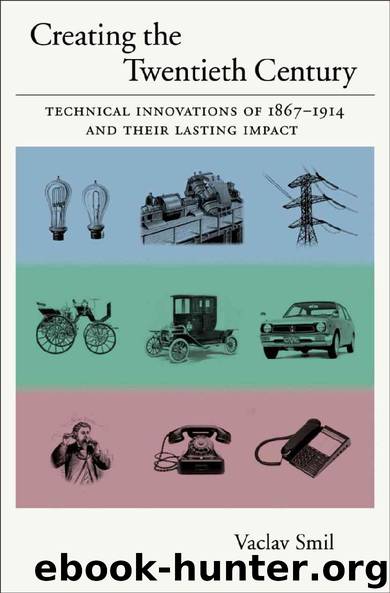Creating the Twentieth Century: Technical Innovations of 1867-1914 and Their Lasting Impact (Technical Revolutions and Their Lasting Impact) by Vaclav Smil

Author:Vaclav Smil [Smil, Vaclav]
Language: eng
Format: epub, azw3
Publisher: Oxford University Press
Published: 2005-07-27T04:00:00+00:00
FIGURE 4.11. Illustrations of aluminum reduction process in Hall’s two U.S. patents (400,664 on the left, 400,766 on the right) granted on April 2, 1889. In both images, A is a crucible, B a furnace, and C the positive and D the negative electrode. The first patent proposed K2Al2F8 as the electrolyte; the second one, Na2Al2F8.
A new plant at New Kensington near Pittsburgh reached output of 900 kg/day by 1894, and in the same year an even larger facility was built at Niagara Falls to use the inexpensive electricity from what was at that time the world’s largest hydro station. In 1907, the Pittsburgh Reduction Co. was renamed Aluminum Company of America, and Alcoa, now a multinational corporation with operation in 39 countries, remains the metal’s largest global producer (Alcoa 2003). Canada’s first plant, the precursor of today’s large multinational Aluminum Company of Canada (Alcan), was built in 1901.
Similarities between Hall’s and Héroult’s independent specifications are striking. Heéroult, who conducted his experiments on the premises of his father’s small tannery and who did not rely on batteries but on a small steam-powered Gramme dynamo to produce a more powerful current, described his invention as a “process for the production of aluminium alloys by the heating and electrolytic action of an electric current on the oxide of aluminium, Al2O3, and the metal with which the aluminium shall be alloyed” (cited in Borchers 1904:127). Like Hall, he also made a provision for external heating of the electrolytic vessel, and his aluminum furnace also had carbon lining and a carbon anode. Héroult’s technique was commercialized for the first time in 1888 by the Aluminium Industrie Aktiengesselschaft in Neuhausen in Switzerland and by the Socieétée Electromeétallurgique Francçaise (Ristori 1911). Larger works, using inexpensive hydroelectricity, were soon established in France, Scotland, Italy, and Norway.
Download
Creating the Twentieth Century: Technical Innovations of 1867-1914 and Their Lasting Impact (Technical Revolutions and Their Lasting Impact) by Vaclav Smil.azw3
This site does not store any files on its server. We only index and link to content provided by other sites. Please contact the content providers to delete copyright contents if any and email us, we'll remove relevant links or contents immediately.
| Africa | Americas |
| Arctic & Antarctica | Asia |
| Australia & Oceania | Europe |
| Middle East | Russia |
| United States | World |
| Ancient Civilizations | Military |
| Historical Study & Educational Resources |
Cat's cradle by Kurt Vonnegut(15088)
Pimp by Iceberg Slim(14198)
4 3 2 1: A Novel by Paul Auster(12201)
Underground: A Human History of the Worlds Beneath Our Feet by Will Hunt(11973)
The Radium Girls by Kate Moore(11860)
Wiseguy by Nicholas Pileggi(5600)
Perfect Rhythm by Jae(5269)
American History Stories, Volume III (Yesterday's Classics) by Pratt Mara L(5210)
The Fire Next Time by James Baldwin(5194)
Paper Towns by Green John(5020)
Pale Blue Dot by Carl Sagan(4852)
A Higher Loyalty: Truth, Lies, and Leadership by James Comey(4779)
The Mayflower and the Pilgrims' New World by Nathaniel Philbrick(4375)
The Doomsday Machine by Daniel Ellsberg(4373)
Killers of the Flower Moon: The Osage Murders and the Birth of the FBI by David Grann(4345)
The Sympathizer by Viet Thanh Nguyen(4260)
Too Much and Not the Mood by Durga Chew-Bose(4222)
The Borden Murders by Sarah Miller(4179)
Sticky Fingers by Joe Hagan(4059)
